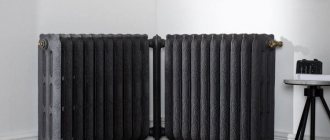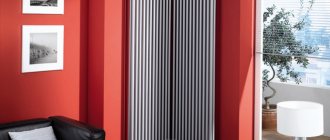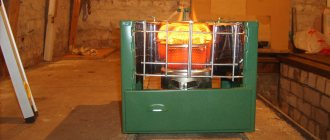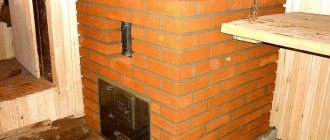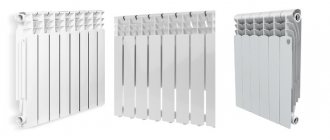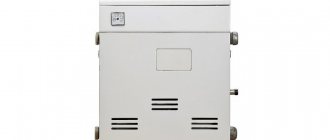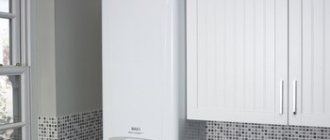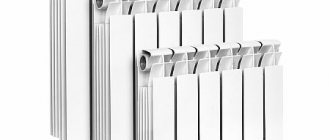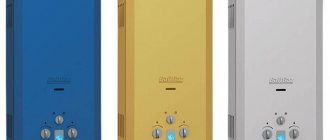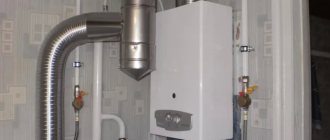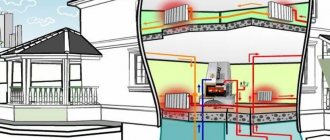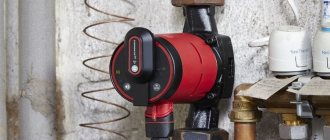Modern technological progress has practically not affected cast iron heating radiators in all 167 years of their existence. Consumers still choose these devices due to the many positive characteristics of the products.
And even some shortcomings do not prevent the installation of cast iron batteries when installing heating systems. Next, we will talk in detail about all the advantages and disadvantages of cast iron radiators, as well as the characteristics that you need to pay attention to before purchasing.
Rating of the TOP 10 best cast iron heating radiators for 2021-2022
| Place | Name | Price |
| TOP 10 best cast iron radiators in price/quality ratio | ||
| 1 | STI Nova 500 | Find out the price |
| 2 | Konner Modern 500 | Find out the price |
| 3 | Viadrus Styl 500/130 | Find out the price |
| 4 | RETROstyle TOULON 500/110 | Find out the price |
| 5 | STI Nova 300 | Find out the price |
| 6 | RETROstyle WINDSOR 500 | Find out the price |
| 7 | Viadrus Bohemia R 450/225 | Find out the price |
| 8 | Konner Modern 300 | Find out the price |
| 9 | Viadrus Bohemia 450/220 | Find out the price |
| 10 | Demir Dokum Floral 750 | Find out the price |
How to choose and what to pay attention to?
To choose an effective and reliable model, you should know some of the nuances of cast iron radiators.
- If your room has a standard ceiling height, a power of 120 W per sq.m. will be sufficient.
- Each section weighs from 3 to 7 kg. After installing the battery, the quantity can be increased or decreased.
- The standard location of batteries is wall-mounted, but floor-mounted ones are also available. For wall-mounted ones, you need to choose a strong bracket or hooks; for floor-mounted ones, “legs” are provided.
- The old type of model holds one and a half liters of coolant, the new ones have less of it - up to 0.8 liters.
- The old ones have a pressure of 8 atmospheres, the new ones - 12-18 atm.
Batteries should not be repainted frequently. Each layer of paint reduces heat transfer.
Design features
When you choose radiators, there are several important points to consider. If you choose sections of radiators, you can increase the heating area if necessary. If the design of the heating radiator is panel, or it is a convector, then you will not change it structurally. When calculations are first made, it is very difficult to take into account all the nuances that will affect the amount of heat required for each individual room. And if the heating battery device is sectional, then this will make it possible to reduce and increase the number of sections, and replace those elements that have failed.
The best cast iron radiators in price/quality ratio
STI Nova 500
Radiator made of lightweight cast iron with good functionality . Maximum number
attached sections - 14.
Warm up quickly with a circulation pump. The heat dissipation is excellent. Connection diameter is 1 inch.
Fuel in the section - no more than 0.52 liters . The distance between the axles is 500 mm. Pressure - 18 bar (pressure testing) and 12 bar (working).
The heat output of the radiator is 120-1680 W. Connection - side.
The outer part is spray painted and pre-treated with a sandblasting machine..
You can install a regulating tap for water supply to the radiator (this will help you regulate the heat yourself using the tap).
Specifications:
- section weight: 4.2 kg;
- section dimensions: 60 mm (width);
- thickness: 85 mm;
- height: 580 mm.
pros
- strength;
- price;
- aesthetic appearance;
- compactness.
Minuses
- narrow passage opening;
- the paint chips easily.
Konner Modern 500
The line of these radiators is very popular and has many positive reviews for several reasons.
Firstly, all models are adapted to Russian operating conditions, secondly, they have high heat transfer, and thirdly, they are easy to install (without the involvement of unauthorized persons) and maintained.
They comply with GOST requirements, as well as international production quality standards.
Quality guarantee - 5 years, service life - 5 times longer. The inlet diameter is 32 mm.
Heat dissipation - 130 W. The test pressure parameters are 1.8 MPa, and the working pressure is 1.3 MPa. The distance between axles is 500 mm.
Specifications:
- section without nipple weighs: 4.14 kg;
- height: 60 cm;
- width: 60 mm;
- depth: 96 mm.
pros
- heat transfer at altitude;
- the buyer can install the radiator without a specialist;
- installed on the wall;
- large sections.
Minuses
- heavy weight of the radiator.
Viadrus Styl 500/130
Radiator adapted for domestic heating systems . Manufacturers
They abandoned the intricate design in favor of reliability and power, but there is no need to hide this device: it is made in a simple, pleasant style with slight asymmetry, and will not look like a “white spot” in your apartment or office.
Long service life, long warranty period, ability to withstand high operating pressure and water hammer - these are other advantages of this radiator.
The heat-resistant paint that covers the models does not fade over time and does not even crack.
The radiator is easy to clean.
The power can be changed to suit your requirements.
Specifications:
- weight: 3.8-76 kg;
- thickness: 130 mm;
- height: 580 mm;
- width of the entire row: 1200 mm.
pros
- powerful;
- any fuel can be used;
- energy efficient;
- easy to maintain.
Minuses
- Nowadays it is rarely found on sale.
RETROstyle TOULON 500/110
Compactness, reliability, functionality - these are the 3 main qualities of the brand’s radiator.
Its appearance is determined by the elegant laconicism of its forms and the absence of unnecessary details.
It will look great in apartments designed in eclectic, loft, grunge and hi-tech styles.
One section is 60 mm wide.
In total, you can install 30 sections - much more. than its analogues. Working pressure - up to 10 sconces, maximum pressure testing - up to 15 bar. In the section - 0.8 liters.
Power range: 158-4740W.
The distance between the axles is 500 mm. Connection is only possible from the side.
All radiators of this brand undergo sandblasting before sale, thanks to which the surface is prepared for further trouble-free painting (the buyer can order it for an additional fee, or do it himself).
Specifications:
- section weight: 4.7 kg;
- section thickness: 110 mm;
- height: 580 mm.
pros
- powerful;
- fashionable;
- cools down slowly;
- It is not afraid of corrosion.
Minuses
- very heavy.
STI Nova 300
A reliable and powerful radiator that can be installed in residential buildings and administrative premises.
Has all relevant certificates and complies with GOST 31311-2005. The section heats an area of 8.5 sq.m. well.
Heat dissipation is high - 850 W. The center-to-center distance is 300 mm. Test pressure - 18 MPa. The maximum working pressure is 12.
The structure is installed on the wall, connected from the side . Nipple hole thread (DN) - G 1. O-rings are made of heat-resistant polymer.
Service life - 30 years . The warranty is issued for 5 years.
Section capacity is 0.3 liters. The maximum coolant temperature is 130 °C. Heat transfer per section: 120 W.
Specifications:
- section weighs 2.8 kg;
- section width: 60 mm;
- thickness: 80 mm;
- height: 380 mm;
- total width: 1200 mm.
pros
- high power;
- reliable;
- long service life;
- good temperature indicators.
Minuses
- connection is possible only from the side.
RETROstyle WINDSOR 500
A real decoration for the apartment, not just a heating device . Optimal proportions
allow you to install the radiator at any convenient point in the apartment.
It is trouble-free, reliable and efficient.
They can last more than 25 years and are made of high-quality cast iron.
Adapters and cast iron plugs are mounted on the radiator depending on the connection diagram.
They are coated with a primer as standard, which allows you to paint them yourself after purchase in any pleasant shade.
Allowed to install up to 30 elements.
The volume of water in the section is 2.3 l. Connection diameter is 1 1/2 inches. The pressure test is 15 bar, the operating pressure is 10 bar. Temperature maximum - 110 °C.
Specifications:
- weight: 11-300 kg;
- section width: 80 mm;
- overall width: 2400 mm;
- thickness: 195 mm.
pros
- beautiful in appearance;
- powerful;
- can be repainted;
- good indicator of maximum temperature.
Minuses
- due to the numerous patterns it is difficult to clean from dust and dirt;
- expensive.
Viadrus Bohemia R 450/225
Compact model, elegant and generously decorated with intricate patterns . will bring
a touch of luxury to any interior: from classic to modern.
It is ideal for domestic heating systems, as it is not afraid of either hard tap water or summer utility “blowdowns” of the system.
Power can be changed at your own discretion . Available in gray, but it is possible to paint the radiator in any color you wish.
The dimensions are small, so it fits comfortably under any window sill.
Maximum operating temperature is 115 °C . A total of 20 sections can be installed. One section holds 2.4 liters of liquid.
Crimping pressure - 16 bar. Connects from the side.
Specifications:
- weight of one section 10.3 kg;
- dimensions (WxHxD): 86x540x225 mm;
- maximum temperature range: up to 115 °C.
pros
- stylish design;
- can be placed on “legs”;
- practical;
- warranty: 20 years.
Minuses
- expensive sections.
Konner Modern 300
An exclusive item with a European design made of high-quality cast iron . Suitable for both
for individual and centralized heating systems, it is characterized by high heat transfer, ease of operation and reliability.
Complies with GOST and all European certificates . One has a width of 64 mm. The maximum number of sections is 12 pieces. Crimping pressure is 18 bar, working pressure is 12 bar.
Quality guarantee - 5 years, service life - more than forty years . Radiator heat output - 120-1440 W. The distance between the axles is 300 mm. Connects from the side (input left, output right).
The volume of water in one element is just over a liter . Not only water, but also oil and antifreeze can be used as fuel.
The kit includes, in addition to the radiator, a set of fittings for connection (Maevsky tap, right plug and 4 through-hole plugs).
Specifications:
- weight: 3.4-40.8 kg;
- thickness: 90 mm;
- height: 400 mm;
- width: 64-768 mm.
pros
- you can use different types of fuel;
- inexpensive;
- withstands high pressure;
- the material is resistant to corrosion.
Minuses
- heavy.
Viadrus Bohemia 450/220
A classic model from a leading European manufacturer of radiators . This option
Suitable for lovers of industrial and retro interiors, as well as for the reconstruction of heating systems in architectural monuments and historically valuable buildings.
The radiator has a 20-year warranty, but its service life is practically unlimited.
The volume of water in the section is 2.4 liters, the total volume reaches 48 liters.
The permissible maximum temperature is 130 °C. The heat output of the radiator is 110-2200 W. Working pressure - 10 bar.
Center distance - 450 mm.
is 110-2200 W. Attached to the wall. The power can be changed additionally.
Specifications:
- weight: 9.9-198 kg;
- width of one section: 86 mm;
- thickness: 225 mm;
- height: 540 mm;
- width: 86-1720 mm.
pros
- easy to care for;
- power can be adjusted manually;
- exquisite appearance;
- meets sanitary and hygienic requirements.
Minuses
- price is above average;
- Only lateral connection is possible.
Demir Dokum Floral 750
Stylish retro-style radiator with an original pattern across the entire surface . External
The view will perfectly enliven any interior.
A section can have from 1 to 15 elements. Can warm a home up to 34 square meters.
The required testing pressure is 12 bar. Center distance - 582 mm. Heat dissipation - 228-3420 W.
The radiator is made by casting gray cast iron, which extends its service life.
Radiators are sold with a set of “legs”, but you can individually order a model without “legs”.
The radiator can be painted, or even artificially aged if desired . The connection type can be any.
The maximum coolant temperature is 110 °C. Maximum operating pressure is 9 bar.
Specifications:
- weight: 13.5-202.5 kg;
- section width: 78 mm;
- thickness: 250 mm;
- height: 750 mm;
- width: 78-1170 mm.
pros
- original appearance;
- easy to repaint;
- high thermal power;
- affordable.
Minuses
- difficult to wash.
Disconnecting the first battery section
Take the radiator disassembly key. If you don't find such a key on sale, you can try making it yourself. To do this, you will need a piece of reinforcement with a diameter of 20 mm and a length of at least 60 cm. In order to unscrew the nipple, we need to flatten one of the ends of the reinforcement to such a state that it is wider than 26 mm, but narrower than 32 mm. To do this, take the burner you have, which you used to heat the plugs. Heat a section of reinforcement about 4 cm long at either end. After heating, use a hammer to shape the tip into a flat shape. If necessary, repeat the heating procedure and hammer the reinforcement section again.
The key can also be made from a piece of pipe with a diameter of 20 mm. To do this, give one end of the pipe a flat shape according to the specified dimensions. When using the factory key to disassemble radiators, you do not need additional equipment. If you have a homemade wrench made from fittings or pipes, it is most convenient to twist it using a pipe wrench. It has enough leverage to rip the nipple out of place. Insert the key into the radiator to a depth sufficient to engage the key and nipple tabs.
Next, start unscrewing the nipple in the direction in which you unscrewed the plug.
You can begin to disassemble the radiator both from the side of the blind plugs and from the side of the through plugs. Remember that they have left and right hand threads respectively. If you unscrew the nipple from the side of the blind plug, then you also twist the nipple clockwise, like a plug. Otherwise, you will break the nipple antennae, and then you will only be able to disassemble the battery using a hacksaw.
Make one or one and a half turns. Next, in the same way, make one or one and a half turns at the bottom of the battery. Unscrew each nipple in turn until the section is completely removed.
You cannot immediately try to unscrew the nipple completely. The section, like the nipple, is made of cast iron and is very fragile. You need to unscrew them gradually so that they don’t burst. If the fastener does not yield, heat the joint with a torch. This will help, as in the case of the cork.
In order to disconnect more than one section, it is not necessary to unscrew each section in turn. You can go straight to the section you need. To do this, use a radiator dismantling wrench to measure the distance to the desired nipple. Make a mark on the key using chalk or a marker. This will allow you not to miss the desired depth at which you need to insert the key. Next, start unscrewing the nipple in the same way as if you were unscrewing one section. It is important to have a key length of at least 50-60 cm in order to easily reach the desired section of the radiator and remove it.
Types of cast iron radiators and their brief description
- Although old models of cast iron batteries are unattractive in appearance, their characteristics are practically not inferior to modern ones. They are cheap (one section is about 350 rubles), they can be different in size, so you need to figure out in advance whether such a battery will fit under the windowsill.
- New generation radiators fit better into modern interiors: they have a smooth surface and a flat front panel. Good quality models are manufactured not only in Europe (Italy and the Czech Republic), but also in Russia.
- Designer models are not hidden, but displayed as room decoration. Most are stylized as products of past centuries, have bas-reliefs, drawings and decorations on the surface, and twisted legs. The size range is wide.
Operating principle: convection vs. radiation
The operating principle of a heating radiator is extremely simple. Water, which has already been heated to the required temperature, flows from the boiler into the room through pipes. Then it enters the heating devices, which heat the air in the rooms of your home.
It is worth noting that if heat is transferred by convection - this is accelerated heating of air that flows through the heating surface, then such a heating device will be called a convector. If heat is transferred by radiation, that is, heating of the surrounding air is produced by a surface that has an increased temperature and heat capacity, then this will be a radiator.
The operating principle of a heating battery can also have a combined form - panel radiators-convectors.
Considering how a heating battery works, it is worth noting that in order to quickly warm up a room, a convector is more suitable. However, such a cross-sectional heating battery has one drawback - due to the passage of active convection, a lot of dust is released into the air, which will not have the best effect on the health of those present. That is why convector batteries are used only where there are problem areas of the heating system. For example, to create an air curtain in a room with a large glass area, where conventional devices cannot fit in size.
Regardless of the temperature in the heating radiators, they will give off approximately 60 percent of the heat by radiating thermal energy, while the rest will be given off by convection. Thus, a minimum of hot air convection is achieved and those objects located in the room are well heated. In this regard, it can be noted that the way a radiator works is similar to a heated floor system.
Advantages and disadvantages of cast iron radiators
Advantages:
- Corrosion resistance is one of the most important properties of cast iron. When moisture gets on its surface, a thin protective film is formed that prevents corrosion from getting inside the cast iron.
- As a coolant, you can use not only water, but also oil and propylene glycol antifreeze.
- Cast iron radiators do not cool down for a long time after being turned off.
- Unlike steel and aluminum radiators, cast iron ones can easily withstand a long stay without coolant without loss. Therefore, the buyer should not worry that something bad will happen to the heating system during the period of summer utility repairs.
- The design feature allows you to repair and improve cast iron radiators without problems. Make it longer or shorter, replace the old part with a new one, throw away the element - no problem!
- The service life of cast iron elements is quite long - 40-50 years.
- They are affordable.
Flaws:
- They are very heavy, require reliable fastening to the wall or a special stand, and older models are also bulky.
- A rough surface attracts dust and makes cleaning difficult.
- The heat transfer surface area is smaller than that of steel and aluminum, and cast iron radiators take longer to heat up.
- Automatic thermoregulation cannot be installed.
Let's start disassembling
To do this, it is better to choose a period when the heating is turned off. Before disassembling the radiator, we recommend removing it from the wall. This will make it much easier and more convenient to work with. In addition, if you have never removed the battery before, then most likely there are no taps at the entrance. This is how radiators were installed during the construction of the house.
It is recommended to install shut-off valves on the pipes at the junction with the battery, in case you make a mistake during subsequent assembly of the radiator and a leak appears. For further dismantling, you will need to shut off the access of water to the radiator, or again wait until the end of the heating season.
Disassembled battery
When disassembling the radiator, it is not recommended to apply too much force to the plugs. To unscrew them, take a gas burner and start heating one of the plugs evenly on all sides. It will take about 5 minutes. During this time, you will get rid of the old paint on the edges of the plug, and will also cause the plug to expand where it connects to the battery section.
Take a 55 mm wrench and try to turn the plug clockwise. If the plug does not turn, there is no need to apply extra effort - turn on the burner and start heating the plug again. It is not advisable to use a pipe wrench. Although it has a wide range of sizes, it can ruin the edges of the cork.
Remember that the blind plug has a left-hand thread. It needs to be unscrewed clockwise.
The older your battery is, the longer it will take to heat the plug. During the period of operation, a lot of dirt, debris, and rust may accumulate at the joints. It often happens that the lower part of the battery is completely clogged and does not heat at all. Be prepared for the fact that the cork will have to be heated red hot. But after that it will easily unscrew. Do the same procedure with the second blind plug.
To remove the passage plugs, take a 36 mm wrench. In the same way, use a torch to heat the connection between the plug and the battery section for 5 minutes. This time unscrew the plugs counterclockwise - they have right-hand threads.
Heating the battery plug
Aluminum or cast iron radiator – which is better?
Models made of aluminum are elegant in appearance and are many times lighter than models made of cast iron. They have high heat transfer and an affordable price .
Unnecessary sections can be easily removed, or a few more can be added if necessary. But if the model has not been treated from the inside with a special polymer composition, then over time it will begin to oxidize from water.
And tap water, which is often too hard and saturated with salts and other chemical compounds, is harmful to it.
Therefore, it is better to install aluminum radiators in private houses with an autonomous heating system.
Cast iron radiators are now produced in different shapes and colors . They are not afraid of corrosion, can withstand water hammer, are able to warm up a home for a long time and, after being switched off, serve for a long time.
However, automatic regulation is impossible on cast iron radiators; they require a lot of water for their normal functioning, and they weigh a lot.
They can be installed in private houses and in apartment buildings.
